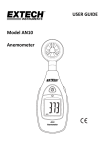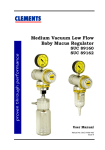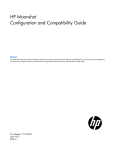Download Errors affecting weighing with portable axle scales
Transcript
Errors affecting weighing with portable axle scales The errors from weighing with portable axle scales has two sources: the scale itself and the so called „external factors“. Error of the scale The error of the scale is obviously the difference between the indication and the load placed on the platform. It can be determined on a suitable test machine or by special test procedures using approved test weights or approved substitution weights. Errors from external factors The external factors are defined as the influences which make a wheel or axle load lower or higher than it would be under perfect conditions. The perfect condition is: absolutely level site, all suspensions of the vehicle in an average, frictionless position, no braking, no vehicle oscillation. This definition shows, that the external factors have nothing to do with the scale accuracy. Or in other words; the scale only can measure what it „feels“. Depending on the configuration used the influence of the external factors is zero (gross weight determined in one operation), or in the worst case (weighing vehicles in poor maintenance condition axle by axle on an unfavorable site) the influence is definitely higher than the error of the scale itself When using a portable weighing system the expected external factors have to be taken into consideration. In order to avoid external errors as much as possible the following measures can be taken: 1. Selection of a even and flat site which is horizontal in the driving direction to eliminate load shift 2. Maintain level approach and exit ramps to eliminate errors due to the vehicle suspension, and to vehicle oscillations. 3. Stopping the vehicle smoothly on the static scale and releasing the brake completely when taking the reading to eliminate errors due to brake reaction forces and friction. 4. Making sure that the wheels are well within the active surface of the scale. The active weighing surface of the scale is dependent on the design of your particular scale and should be verified by performing a shift test on the platforms. The effects of site level on accuracy 1. Tilting of the vehicle causes a displacement of the centre of gravity and thus a load shift towards the lower wheels. 2. Tilting of the scale leads to a lower indication, because the scale only registers the force component rectangular to the scale platform. Therefore weighing on a slope shows different results than on a level site. The following table shows the influence of weighing on slopes. Gradient Gradient Gross Weight Axle Load Wheel Load Crosswise 0% Unaffected Unaffected Unaffected Crosswise 5% Unaffected Unaffected Affected Lengthwise 0% Unaffected Unaffected Unaffected Lengthwise 5% Unaffected Affected Affected The effect of brake reaction forces on accuracy Depending on how the braking forces are transferred to the vehicle chassis, the axles may be under tension if the brake is not released. After releasing the brake the vehicle goes into its normal position, provided that there is no friction in the suspension. To prevent from all unfavorable effects the driver must release the brake before the reading is taken. If the site is not perfectly level it is not possible to release the brake for a longer time interval. The effects of vehicle oscillation on accuracy A vehicle in movement is always oscillating more or less in vertical direction operators must take their time to capture the weights once the vehicle as reached its minimum oscillation. Some scale systems are equipped with filtering to help speed up this settling process. Conclusion The gross vehicle weight indication is not affected as long as the maximum gradient stated in the user manual of the scale is respected in order to prevent from malfunction of the scale system. The same is true for the axle weight as long as the vehicle is of common dimensions, loaded in a way that the load is not extremely concentrated and weighed on a site which is reasonably horizontal in the driving direction. A site may be considered as horizontal if a vehicle does not roll away at once when the brakes are released. The wheel weights are most susceptible for tilting of the weighing site in crosswise direction. The effect compensates fully if the wheel weights are used for calculating the axle weight only. Absolute worst case Example The following assumption was made in order to give an idea what differences are possible in the worst case. Such a vehicle may have a wheel base of 4 m, an average track width of 1.6 m and its centre of gravity 1 m ahead of the rear axle, 0.2 m off the lengthwise centerline and 2.5 m above the road surface. A gradient of 2 % will result in the following load differences: Total weight: The effect is negligible Axle load: The effect is negligible as long as the slope is crosswise to the driving direction. With a slope of 2 % lengthwise the following differences in relation to the actual axle loads will occur: +/-1,7 % for the rear axle and -/+ 5 % for the front axle. (First sign: uphill; second sign: downhill.) Wheel load: The biggest effect occurs in the case of a crosswise gradient. The difference in relation to the actual wheel load is -/+ 2,8 % for the more heavily loaded and +/- 3.6 % for the less heavily loaded wheel. (First sign: centre of gravity shifted towards the higher wheel; second sign: towards the lower wheel). The user may reduce all above effects to a big extent by selecting an appropriate weighing site. Formula for calculation the indication difference caused by the gradient of the weighing site Ref: F. Scheuter














